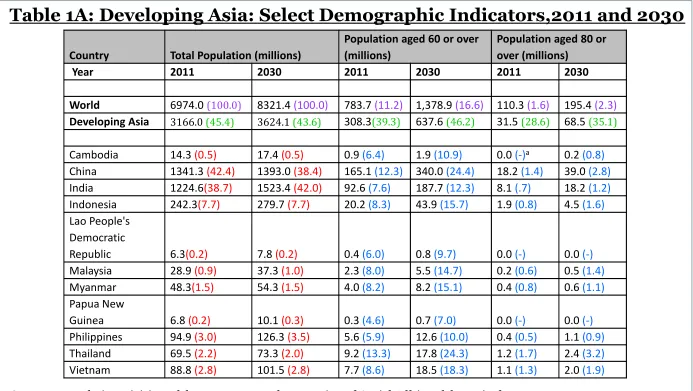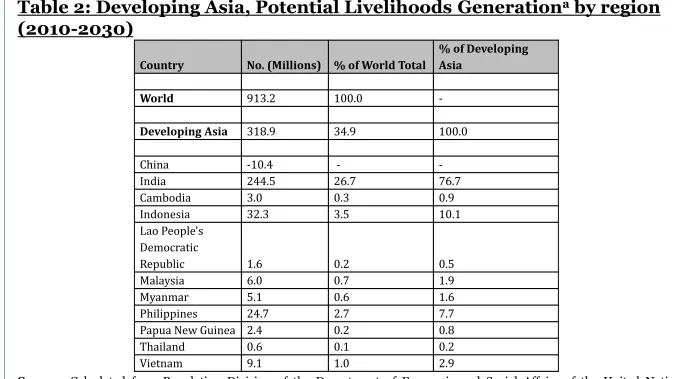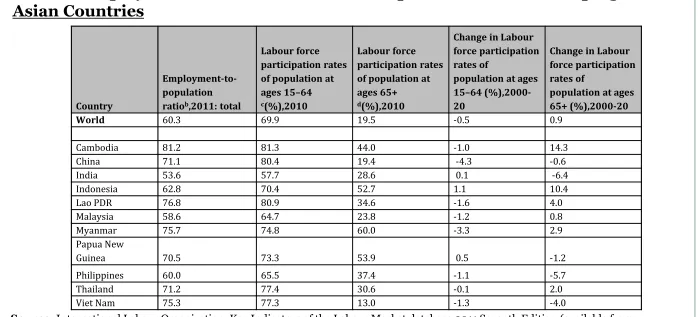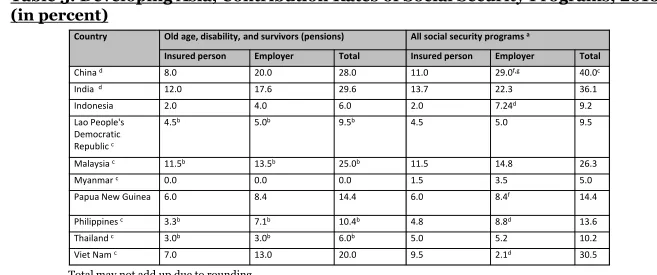M U K U L G . A S H E R
P R O F E S S I O N A L F E L L O W , N A T I O N A L U N I V E R S I T Y O F S I N G A P O R E ; A N D C O U N C I L O R , T A K S H A S H I L A I N S T I T U T I O N
Financing Social Protection in
Developing Asia:
Now and In the Future
-Prepared for Asia Policy Forum on Poverty, Inequality and Social Protection,Jakarta,
May 27, 2013
ORGANIZATION
The Context
Financing Options and Issues
Concluding Remarks
ABSTRACT
Demographic trends portend rapid aging of developing Asia, albeit at
varying rates. This phenomenon, along with the need to extend
coverage of social protection system, is likely to increase public and
private expenditure on social protection, particularly for pensions and
health care. This paper analyses the options for additional financing of
social protection in Asian countries, and their implications for the
financing mix involving public and private sectors. The indications are
that as overall resources devoted to social protection increase both the
government budgetary support (requiring fiscal space), and individual
and household financing will need to increase. The paper explores
these avenues, including possible efficiency gains from improving
professionalism of provident and pension fund organizations in Asia.
The paper also briefly discusses the possible role of social pensions in
Asia.
The Context /1
is emerging as an important public policy
issue in developing Asia (broadly excluding
high-income Asian economies of Japan,
South-Korea, Singapore, Brunei, Taiwan
and Hong Kong).
Social Protection
The Context /2
5 The term Social protection does not have a precise analytical meaning. The
term is used by different analysts according to the policy questions being addressed.
The broadest definition is by UNRISD (United Nations Research Institute
for Social Development). It defines the term as comprising “…policies and programs designed to reduce poverty and vulnerability by promoting
efficient labor markets, diminishing people’s exposure to risks, and
enhancing their capacity to manage economic and social risks, such as unemployment , exclusion, sickness, disability and old age” (UNRISD, 2010.)
The old age pensions or retirement financing, and healthcare are among the
The Context /3
DEMOGRAPHIC TRENDS
-reflected in declining fertility rates and increasing life
expectancy, portending rapid ageing. (Tables
1
a to
1
c)
•
Between 2011 and 2030, Developing Asia’s
share in global population will decline slightly
(from 45.5 % to 43.6%) , but its proportion in
global aged (above 60 and above 80) will rise
markedly (from 39.4 % to 46.4%, and 28.8 % to
35.3 % respectively).
•
This implies more rapid pace of aging than for
Table 1A: Developing Asia: Select Demographic Indicators,2011 and 2030
Source:Population Division of the Department of Economic and Social Affairs of the United
Nations Secretariat, World Population Prospects: The 2010 Revision,http://esa.un.org/unpd/wpp/index.htm,Accessed on February 28, 2013 and 20 May, 2013.
Percentage of total world population Percentage of Developing Asia
Percentage of respective world population Percentage of the country’s total population a ‘-‘stands for negligible
Note: Figures for China, India and Papua New Guinea are for the years 2010, 2030
Country Total Population (millions)
Population aged 60 or over (millions)
Population aged 80 or over (millions)
Year 2011 2030 2011 2030 2011 2030 World 6974.0(100.0) 8321.4(100.0) 783.7(11.2) 1,378.9(16.6) 110.3(1.6) 195.4(2.3)
Developing Asia 3166.0(45.4) 3624.1(43.6) 308.3(39.3) 637.6(46.2) 31.5(28.6) 68.5(35.1) Cambodia 14.3(0.5) 17.4(0.5) 0.9(6.4) 1.9(10.9) 0.0(-)a 0.2(0.8)
The Context /4
•
The share of elderly in Developing Asia of three
countries, China, India and Indonesia.
•
This implies how these three countries address the
financing (and other challenges) coping with the
aging population and will have major bearing on
how Developing Asia as a whole addresses
demographic related challenges.
•
The challenge is most countries of Developing Asia
Total Fertility Rate (TFR), life expectancy and
median age
will continue to be lower than the
global average.
Table
1
B: Fertility Rate, Life Expectancy and Median Age in Developing Asian CountriesSource:Population Division of the Department of Economic and Social Affairs of the United Nations Secretariat,World
Population Prospects: The 2010 Revision,http://esa.un.org/unpd/wpp/index.htm,
http://unstats.un.org/unsd/demographic/products/socind, accessed on February 25, 2013 and 20 May, 2013
aNote: The average number of children a hypothetical cohort of women would have at the end of their reproductive period if they were
subject during their whole lives to the fertility rates of a given period and if they were not subject to mortality. It is expressed as children per woman.
Country Total Fertility Ratea Life expectancy at birth
Life expectancy at
age 60 (2010-15) Median Age Year 2010-2015 2025-2030 2010-2015 2025-2030 Male Female 2010 2030 World 2.5 2.3 69.3 72.4 18.0 22.0 29.2 34.1
Cambodia 2.4 1.9 63.7 69.5 16.0 17.0 22.9 31.3
China 1.6 1.6 73.8 76.4 18.0 21.0 34.5 42.5 India 2.5 2.2 66.0 69.9 16.0 18.0 25.1 31.2
Indonesia 2.1 1.8 70.0 74.3 17.0 19.0 27.8 35.1
Lao People's Democratic
Republic 2.5 1.9 67.9 72.4 16.0 18.0 21.5 30.2
Malaysia 2.6 2.2 74.6 77.1 18.0 20.0 26.0 31.7
Myanmar 1.9 1.7 66.0 71.1 16.0 18.0 28.2 35.9
Papua New Guinea 3.8 3.1 63.3 68.0 14.0 17.0 20.4 24.5
Philippines 3.1 2.6 69.2 72.5 16.0 19.0 22.2 27.1
Thailand 1.5 1.5 74.4 76.8 19.0 22.0 34.2 41.8
The Context /5
•
In contrast, the Old-age Dependency Ratio
(ODR), and its converse (the number of
economically active age supporting an elderly)
will continue to be higher in Developing Asia
than the global average.
Table
1
C: Trends in Old-Age Dependency Ratios in Developing Asian Countries, 2010 and 2030Source: Population Division of the Department of Economic and Social Affairs of the United Nations Secretariat, World
Population Prospects: The 2010 Revision,http://esa.un.org/unpd/wpp/index.htm, Accessed on March 4, 2013 and 20 May, 2013
aNumbers in parentheses refers to the population support ratio defined as persons between ages 15-64 which could potentially support those above 65; calculated as inverse of the old age dependency ratio.
Country Old-Age Dependency Ratioa
Year 2010 2030
World 11.6 (8.6) 18.0 (5.6)
Cambodia 5.9 (16.9) 10.2 (9.8)
China 11.0 (9.1) 24.0 (4.2)
India 8.0 (12.5) 12.0 (8.3)
Indonesia 8.2 (12.1) 15.1 (6.6)
Lao People's Democratic
Republic 6.3 (15.9) 9.1 (11.0)
Malaysia 7.4 (13.6) 15.7 (6.4)
Myanmar 7.4 (13.5) 14.1 (7.1)
Philippines 6.0 (16.8) 10.4 (9.6)
Papua New Guinea 5.0 (20.0) 7.0 (14.3)
Thailand 12.6 (7.9) 26.1 (3.8)
The Context /6
LABOUR MARKET DYNAMICS –
suggesting
continuing
high
informality
and
contractual labor in the labor market. (Table 2)
• Data in Table 2 suggests that between 2010 and
2030, Developing Asia will need to generate 35 percent of livelihoods globally, with India alone accounting for 27 percent.
• The challenges of livelihoods creation will be
severe in India, Indonesia and the Phillipines while China is projected to exhibit shrinking of the labor force (Table 2).
Table 2: Developing Asia, Potential Livelihoods Generationa by region
(2010-2030)
Country No. (Millions) % of World Total
% of Developing Asia
World 913.2 100.0
-Developing Asia 318.9 34.9 100.0
China -10.4 -
-India 244.5 26.7 76.7
Cambodia 3.0 0.3 0.9
Indonesia 32.3 3.5 10.1
Lao People's Democratic
Republic 1.6 0.2 0.5
Malaysia 6.0 0.7 1.9
Myanmar 5.1 0.6 1.6
Philippines 24.7 2.7 7.7
Papua New Guinea 2.4 0.2 0.8
Thailand 0.6 0.1 0.2
Vietnam 9.1 1.0 2.9
Source: Calculated from Population Division of the Department of Economic and Social Affairs of the United Nations Secretariat,World Population Prospects: The 2010 Revision, http://esa.un.org/unpd/wpp/index.htm, accessed on February 28, 2013 and 21stMay, 2013.
The Context /7
• As India’s employment to population ratio (53.6) is
much lower than the global average (60.3), (Table 3), it has the potential to grow faster if it raises this ratio. But this will require a more conducive environment
for employment and livelihood creation. Such
emphasis is also needed for Indonesia and the Philippines.
• Labor force participation rate of the aged population
in developing Asia (with the exception of China and Vietnam) is substantially higher than the global average. Thus the elderly in most developing Asia are already participating in the labor market.
Table 3: Employment and Labour Force Participation Rates in Developing Asian Countries
Source: International Labour Organization, Key Indicators of the Labour Market database,2011 Seventh Edition (available from
http://www.ilo.org/empelm/pubs/ WCMS_114060/lang--en/index.htm), accessed on March 1,2013 and May 22,2013 and World Social
Security Report,2010-11.
aTable is based on latest data available
bThe proportion of the working-age population that is employed. For most countries, the working-age population is defined as persons aged 15 and above, although that may vary slightly from country to country.
cLabour force participation rates of population at ages 15–64 (%) = Economically active population aged 15–64 / Population aged 15–64
dLabour force participation rates of population at age 65 and over (%) = Economically active population aged 65 and over / Population aged 65 and over
Note: Employment to population ratio figures for India, China and Papua New Guinea are for the year 2010 Country
Employment-to-population ratiob,2011: total
Labour force
World 60.3 69.9 19.5 -0.5 0.9
Cambodia 81.2 81.3 44.0 -1.0 14.3 China 71.1 80.4 19.4 -4.3 -0.6 India 53.6 57.7 28.6 0.1 -6.4 Indonesia 62.8 70.4 52.7 1.1 10.4 Lao PDR 76.8 80.9 34.6 -1.6 4.0 Malaysia 58.6 64.7 23.8 -1.2 0.8 Myanmar 75.7 74.8 60.0 -3.3 2.9 Papua New
The Context /8
16• Since informalization of the labor force is expected to
continue to be high in Developing Asia, extending social protection to them will be a major challenge.
• This is reflected in low effective coverage of the labor
force (Table 4).
• For the pensions, active contributions as percentage of
working age population globally is only about a quarter. Thus, three-fourths of working age population does not have a pension coverage.
• In developing Asia, except for Malaysia and the
The Context /9
17• The coverage however does not necessarily imply
adequate risk mitigation or benefit levels.
• As demand for social protection increases, the coverage
including benefit levels, will also need to increase.
• Indeed UNRISD, ILO and HelpAge International and
others have argues for a universal social protection provision globally. (http://www.helpage.org/)
18 Country Estimate of legal
coveragegfor old age (%
of the working-age China 25-50 22.4 31.9 15.7 Less than one-third 87.1 India 25-50 6.4 7.5 - Less than one-third * Indonesia Less than 25 14.1 23.7 18.8 None 100 Lao PDR Less than 25 0.7 7.3 - None 100 Malaysia 25-50 63.8 67.6 48.6 None 100 Myanmar - - - - None 100 Papua New
Guinea Less than 25 - 11.5 - None 100.0 Philippines 50-75 54.7 50.4 62.7 None 100 Thailand 50-75 21.3 27.5 21.3 Between one-third and
two-third
85.3 Viet Nam Less than 25 12.4 23.7 15.5 Less than one-third 100
Table 4: Legal and effective coverage of selected branches of social security in Developing Asian Countries, 2010-11
Source: Constructed from World Social Security Report, 2010-11. Sources by column are given below:
aTable 16,Page 208,bTable 21, Page 240,cTable 17,Page 216,dTable 23, Page 253,eTable 18, Page 223,fTable 22a,page 245 - = Data not available;g
Legal coverage is distinct from effective coverage. A population group can be identified as legally covered if there are existing legal provisions that such a group should be covered by social insurance for a given branch of social security, or will be entitled to specified benefits under certain circumstances for instance, to an old-age state pension on reaching the age of 65, or to income support (including old-age social pension) if income falls below a specified threshold;hRegional estimates are weighted by population
The Context/10
Greater need for and higher expectations generated for
better social protection (requiring a shift in policy
focus from absolute income to relative income) due to
:
Urbanization(al
share is rising)
,
FINANCING OPTIONS AND ISSUES /
1
It is essential to distinguish between funding in an economic sense and
financing i.e. the mix of instruments or methods such as social
insurance primarily financed from contributions, budgetary financing,
mandatory or voluntary saving, etc.
The financing mix can be broadly divided into public and private sector
shares. For pensions, the data collection both nationally and
internationally is in terms of public spending and thus includes private
spending. For healthcare however, there have been attempts to estimate
national health expenditure and to delineate public-private shares.
FINANCING OPTIONS AND ISSUES /
2
The concept of economic funding is based on the premise that the
primary source of economic security for both the young and the old is
dependent on the current level of GDP and its trend in rate of
growth.
(Barr and Diamond, 2008)
Thus any financing mix arrangements should be structured so as to
enhance (or at least not diminish) core rate of economic growth.
Greater share of GDP devoted to the elderly should ideally be from
reduced consumption of rest of the population and of the government,
rather than from the investment expenditure.
The above also implies that merely requiring mandatory saving for
retirement purposes does not necessarily imply funding in an
economic sense.
FINANCING OPTIONS AND ISSUES /
3
What will be the extent of financing needed for social protection in the
future in Developing Asia?
This is not an easy question to address as unlike for the OECD
countries, there are no systematic studies of pension and health care
expenditure for Developing Asia.
IMF(2011) has projected public pension expenditure as follows:
(Appendix Table 4, p.53)
The global average will increase from 7.0 percent of GDP in 2010 to 8.1 percent by 2030, and to 9.7 percent by 2050.
The corresponding share for advanced countries are 8.4, 9.6, and 11.0
FINANCING OPTIONS AND ISSUES /
4
23
Among the Developing Asia, China’s share will increase from 3.4 in 2010 to 6.7 in 2030 and 9.2 in 2050, implying need for additional fiscal space of 5.8 percent of GDP between 2010 and 2050.
If private expenditure on pensions were added, greater proportion of
GDP will need to be diverted to old age financing.
Social protection also involves health care, and other programs.
FINANCING OPTIONS AND ISSUES /
5
If expenditure on these were taken into account, and expectations of substantially greater coverage were to be realized (eg. through social pensions), fiscal space and additional societal resources needed for aging populations will be ever larger.
Estimates of fiscal costs of social pensions have been summarized in
Asher(2012).
In New Zealand, fiscal costs in 2009-10 were 4.3 percent of GDP; expected to increase to 8 percent of GDP by 2050.
In Australia, the fiscal costs of means tested pensions were 2.7 percent of GDP in 2009; projected to be 3.9 percent in 2050.
ILO has estimated that modest social pensions in low and middle income countries would be around 1 percent of GDP; but its estimates for full social protection package range from 3.7 percent to 10.6 percent of GDP.
FINANCING OPTIONS AND ISSUES /
6
25
Even 1 to 1.5 percent cost range would require substantial fiscal reform in tax systems generating revenue of between 10 to 15 percent of GDP.
Even without robust fiscal cost projections, Developing Asia will need to generate substantial fiscal space to finance social protection.
Fiscal space may be defined as “…the financing that is available to government as a result of concrete policy actions for enhancing resource mobilization, and the reforms necessary to secure the enabling governance , institutional and economic environment for these policy actions to be effective for a specified set of development objectives.” (Roy, Heuty and Letouze ,2007).
FINANCING OPTIONS AND ISSUES /
7
26
It thus helps to reconcile narrow fiduciary view and developmental
view of social protection.
In post 2008 global environment fiscal and debt sustainability issues
need to be addressed much more completely and seriously if they are
not to impinge on economic growth and stability of Developing Asia.
(
Ferrarini et al 2012
).
There are several avenues to generate fiscal space and finance and
fund social protection expenditure.
FINANCING OPTIONS AND ISSUES /
8
27
Thus administrative and compliance costs funds in countries such as India, Indonesia and the Philippines remain high.
The 2004 SJSN Law of Indonesia has insufficient clarity on financing, benefits etc., and does not adequately address needs for appropriate organizational incentive structures. These may generate contingent fiscal liabilities.
2.
Enhancing competence to generate resources from unconventional
sources, such as utilizing state assets, including land, property rights
such as air-space, and oil and mining resources more completely and
productively.
FINANCING OPTIONS AND ISSUES /
9
28
4. Conventional tax reforms, improving compliance levels and efficiency .
5. Use of Sovereign Wealth Funds(SWFs), current surplus income and wealth over generations. China has been using this avenue.
6. Financial innovations, particularly at the pay-out phase is accumulation schemes.
• The conventional practice of relying on annuities will be inadequate given
limited financial instruments to mitigate longevity risk, and due to uncertainties in longevity trends due to uncertainties in medical technology breakthroughs.
• Such innovations, which reduce transaction costs of service delivery and
FINANCING OPTIONS AND ISSUES /
10
29
7. Some high income countries have attempted to finance old age by developing instruments which convert real estate into a retirement consumption stream. They have however had a fairly limited success.
8. In developing Asia the individuals and the households will need to bear a greater proportion of increased share devoted to old age financing. Promoting its secure and stable policy and regulatory environment for long term savings by the individuals should therefore be an important instrument for financing old age. But this needs to be undertaken without creating contingent liabilities or fiscal risks.
FINANCING OPTIONS AND ISSUES /
11
30
To realize the objective of more robust systems, each country will need to structure a combination of options suited to its context and capacities.
Country Old age, disability, and survivors (pensions) All social security programsa
Insured person Employer Total Insured person Employer Total
Chinad 8.0 20.0 28.0 11.0 29.0f,g 40.0c
India d 12.0 17.6 29.6 13.7 22.3 36.1
Indonesia 2.0 4.0 6.0 2.0 7.24d 9.2
Table 5: Developing Asia, Contribution Rates of Social Security Programs, 2010 (in percent)
Total may not add up due to rounding
Source: Constructed from Social Security Programs
Throughout the World: Asia and the Pacific, 2012, available at: http://www.ssa.gov/policy/docs/progdesc/ssptw/2012-2013/asia/ssptw12asia.pdf
a. Includes Old Age, Disability, and Survivors; Sickness and Maternity; Work Injury; Unemployment; and Family Allowances. In some countries, the rate may not cover all of these programs. In some cases, only certain groups, such as wage earners, are represented. When the contribution rate varies, either the average or the lowest rate in the range is used.
b. Also includes the contribution rates for other programs. c. Contributions are submitted to a ceiling on some benefits.
d. Employers pay the total or most of the cost of work injury benefits.
e. Government pays the total cost of the universal old-age and disability pensions. f. Employers pay the total or most of the cost of work injury benefits.
CONCLUDING REMARKS/1
32
The prominence of social protection and its financing as a public policy issue will
become greater in the future due to variety of factors such as demographic and labor market trends, urbanization, internal and cross border labor mobility, rising living standards and global integration.
While the databases and future age related expenditure projections are not robust
in Developing Asia, a gap which must be addressed at the individual country levels and at the regional level, it is clear that constructing more robust social protection system will require substantial fiscal space as well as private funding.
Each country will need to fashion its own combination of various fiscal and other
options to meet the financing needs.
These options should not be construed narrowly as essentially contributions or
taxes but more broadly involving such areas as more enhancing capacities to generate resources from unconventional sources, and obtaining resource savings
through greater professionalism, policy coherence, and organizational
CONCLUDING REMARKS/2
33
The financing aspects would also need to be tied with greater integration of the elderly in the community, including creating an environment in which their economic potential could be realized.
REFERENCES
Asher, M G, "Social Pensions for the Elderly in Asia: Fiscal Costs and Financing Methods". In Social Protection for Older Persons: Social Pensions in Asia, ed. S. W. Handayani & B. Babajanian. Manila: ADB, 2012. 23 pp
Bali, A., and Asher, M.G. , 2012, Coordinating Healthcare and Pension Policies: An
Exploratory Study, Tokyo : Asian Development Bank Institution Working Paper No.
374,
http://www.eaber.org/sites/default/files/documents/2012.08.16.wp374.coordinating.h ealthcare.pension.policies.pdf, accessed on May 21, 2013.
Barr, N. , and Diamond, P. , 2008, Reforming Pensions: Principles and Policy Choices,
New York : Oxford University Press,
http://econ.lse.ac.uk/staff/nb/Barr_Diamond_crr.pdf , accessed on May 23, 2013.
Clements, B. and Coady, D. , 2011, The Challenge of Public pension Reform in
Advanced and Emerging Economies, Washington, D.C. : International Monetary Fund,
Fiscal Affairs Department.
Ferrarini, B., Jha, R.,& Ramayandi, A. (eds.) (2012). Public Debt Sustainability in
Developing Asia. New York: Routledge.
REFERENCES
Roy, R., Heuty, A., and Letouze, E. , 2007, Fiscal Space For What? Analytical
Issues from a Human Development Perspective, UNDP Paper for the G-20 Workshop on Fiscal Policy, Istanbul, June 30 – July 2.
UNRISD, 2010, Combating Poverty and Inequality: Structural Change,
Social Policy and Politics, Geneva: UNRISD,
http://www.unrisd.org/publications/cpi , accessed on May 23, 2013.



